Content
- Operating principle
- Views
- Standard
- Individual
- Silicone
- Polyurethane
- Popular models
- Invisalign
- Ortho snap
- 3D Smile
- Get dent
- Treatment stages
- Application
- How to put on
- How to shoot
- Oral hygiene rules
- Construction storage rules
- Selection recommendations
- Dignity
- Flaws
- Video about aligners for teeth straightening
Aligners for teeth straightening (aligners) - removable transparent arched pads made of high quality silicone or bioplastic material. The aligners are precisely shaped, practically invisible on the teeth and do not require special care. Removable structures are used to correct the position of dental units. The price for mouthguards depends on the type of the chosen design.
Operating principle
The principle of operation of mouth guards does not differ from standard orthodontic constructions. With a constantly acting force on the dental unit, on the side of the tooth socket, on which pressure is exerted, the bone tissue is gradually destroyed. And on the side where the stretching occurs, on the contrary, the formation of bone tissue is observed. Thus, there is a movement of dental units in a given direction.
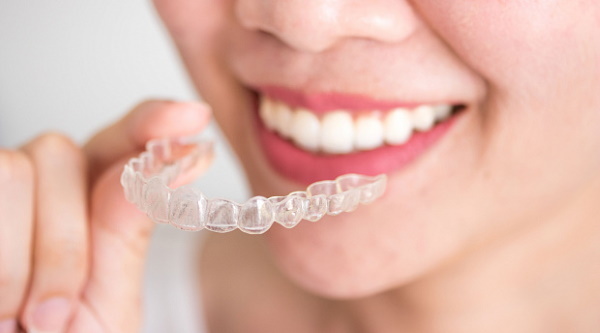
Due to the fact that these processes are rather slow, the effect on the tooth should be moderate. Most often, mouth guards with a thickness of 0.75 mm are used. The pressure on the tooth is transmitted using special attachments that are fixed on the teeth. In orthodontics, dental units are affected in different ways.
And if braces are a complex orthodontic construction, which consists of rubber rods and springs that require constant activation, then aligners are quite easy to use. The force on the tooth with the help of caps is regulated in a computer program.
Views
Depending on the technology of creating structures, the type of material used and the duration of wearing, mouthguards are divided into types.
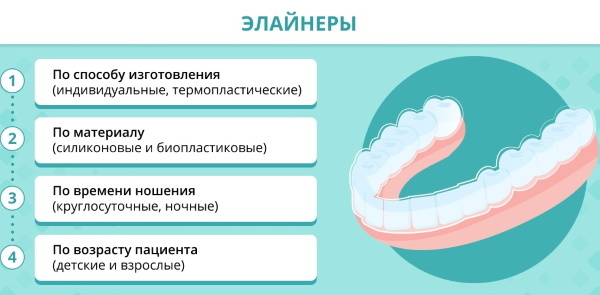
| By technology of creation | · Standard; · Individual. |
| By the duration of wearing | · Round the clock; · Night. |
| By type of materials used | · Silicone; · Polyurethane. |
Standard
Standard mouthguards are made of thermoplastic and are created according to a specific pattern without taking into account individual characteristics. Such structures are made of a plastic material that softens when exposed to high temperatures. In order to use the mouthguard, it is enough to dip it into a container with hot water, and then put it on the dentition. When hardened, the mouthguard will take the shape of the teeth. Standard mouthguards can be purchased at a price of $ 5,000 to $ 10,000. rub.
Individual
Individual mouthguards exactly follow the shape of the patient's teeth, since they are made by taking plaster and 3D impressions from the jaw, taking into account the peculiarities of the bite and dentition. The principle of operation of the caps is associated with a mechanical effect on the dentition and the alignment of the teeth in the desired direction.
After the dental unit takes the desired position, the cap of the structure fixes it and prevents it from moving further. For this reason, the aligners are changed every 2-3 weeks, taking into account the correction of the dentition.
Silicone
Alignment caps for teeth straightening (the price depends on the technology of creating the structure), made of silicone, are designed to correct minor malocclusions.
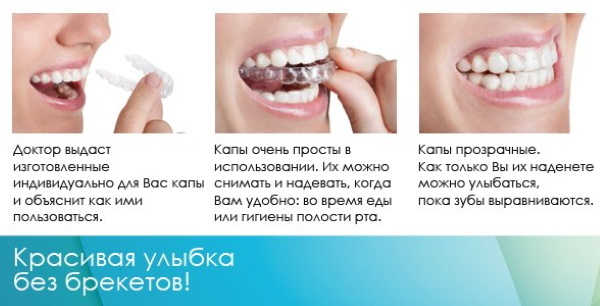
Silicone aligners are thicker than polyurethane products, therefore they are more noticeable and tangible on the teeth, but they have a lower cost - about 7-8 thousand rubles. rub. for one mouthpiece.
Polyurethane
Polyurethane is a more durable material than silicone. Therefore, aligners made of polyurethane are thin and hardly perceptible orthopedic products. The price of one structure is about 15-20 thousand rubles.
Popular models
There are 3 popular aligner manufacturers that offer custom made products for each occasion using 3D technology.
Invisalign
Mouth guards are made in the USA on the basis of a volumetric model of the patient's oral cavity, created using an impression taken from both jaws. After creating an impression, it is sent to the laboratory in order to reproduce a 3D model, which is a virtual display of the results obtained. With the help of three-dimensional modeling, it is possible to predict the course and movement of the dentition that will occur during the wearing of the mouthguard.
After the orthodontist gives an agreement on the creation of the desired model, polymer aligners are made in the laboratory for further use. The price of such a structure varies from 250 to 400 thousand. rub. The price includes the amount of caps required for the course of treatment.

A complete set of mouth guards includes from 10 to 40 mouth guards, which should be changed every 14-21 days. The mouthguards are supplemented with an individual container in which you need to store products during meals or during hygiene procedures. The duration of treatment with Invisalign caps is 6-8 months.
Ortho snap
Aligners are produced by an American company that has been on the market for about 10 years. To create a cap, the manufacturer uses not computer modeling, but DPM technology. It involves the creation of a dynamic model of the jaw, which becomes the basis of the entire treatment process. The created model accurately repeats the movement of the teeth, which is carried out when using the mouth guards.
Thus, a complete set of aligners is created, each of which is suitable for a specific position of the dental unit. It takes about 4-6 weeks to make caps. After that, the patient receives a complete set of products. It is necessary to wear aligners for 20-22 hours a day. The duration of treatment with mouth guards depends on the specific clinical case and can range from 6 to 24 months. The cost of 1 set of aligners (up to 7 pcs.) Is 220 thousand. rub.
3D Smile
Mouthguards are made in Russia. The aligner kit is created using 3D printing. At the initial stage of the development of caps, diagnostics is carried out taking into account the peculiarities of the dentition and occlusion of the patient, as well as his gender, facial expressions, and age. Using a 3D printer, an accurate product is printed from a polymer blank, which fully complies with the declared parameters.
The advantages of using a Russian brand include:
- creation of caps using American technology;
- shortened creation time due to domestic production;
- affordable price compared to other manufacturers;
- the use of hypoallergenic material.
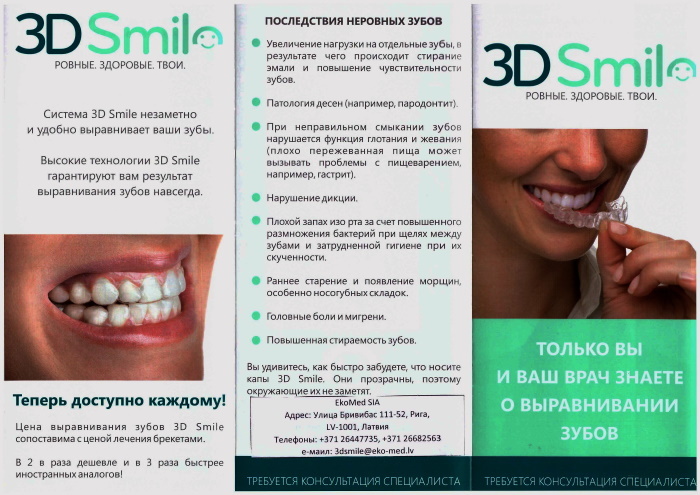
Russian-made mouth guards will get rid of dental problems in 3-15 months. The cost of a 3D Smile cap is 130-150 thousand. rub. for a set of caps required for the course of treatment.
Get dent
Aligners of the Russian manufacturer, made of thermoplastic plastic.
The mouthguard will solve such problems as:
- twisted teeth;
- gaps between teeth;
- the presence of a deep or cross bite;
- cases with combined problems.
The advantages of Get Dent include the creation of a free 3D model and a relatively low cost of treatment. The cost of aligners is calculated individually, based on the treatment plan, and is 70-170 thousand. rub. The duration of treatment depends on the specific clinical case. With slight curvatures and twisting of the teeth, it will take from 3 to 8 months. In more severe cases requiring bite correction, it will take 8 to 15 months.
Treatment stages
Treatment with caps begins with the elimination of all inflammatory and carious processes. Before installing the aligners, a complete sanitation of the oral cavity is carried out. To exclude the likelihood of inflammation in the periodontium, it is necessary to make an x-ray, a teleradiograph and a CT scan of the jaw. It takes about 1-1.5 months to make individual caps.
The process of creating products consists of the following stages:
- Jaw scans and digital impressions.
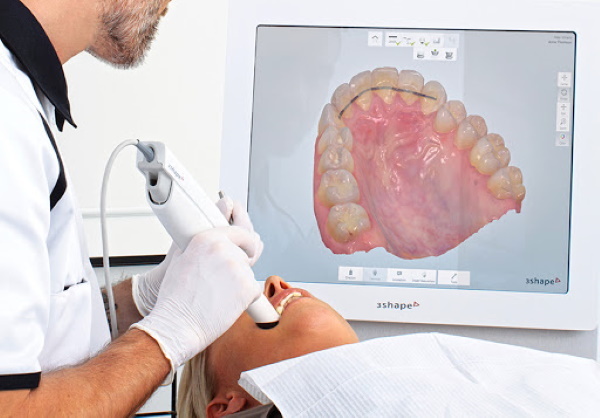
- Creation of face and jaw photos in front view and in profile.
- Creation of a digital 3D model based on impressions, which allows you to estimate the future result in advance. The entire treatment process was initially simulated in a computer program. The course of movement of the dentition will be monitored and regulated by a computer, which will allow the mouthguard to be selected according to the new change.
- Sending data to the laboratory for the manufacture of caps.
- Getting an individual set of aligners. Their number in the future will depend on the specific clinical case. On average, 8 to 50 pairs of caps are used during treatment.
- The orthodontist installs the first pair of caps on his own, the rest is changed by the patient himself according to the established schedule. The doctor installs attachments on the teeth - activators, which allow you to firmly fix the aligner and make it possible to rotate it in a given direction. Attachments are fixed according to a template that is specified by a computer program. Activators are made of a composite material that matches the color of the tooth enamel.
Application
The use of mouth guards does not require special training and restrictions. To achieve the desired result, you need to wear trays for at least 22 hours a day. The duration of the use of removable structures depends on the nature and degree of the defect in the dentition and occlusion. Chewing gum is prohibited when using aligners. There are no other dietary restrictions.
It is also not recommended to smoke during the use of the cap, since tobacco smoke can change the color of the material.
How to put on
Alignment aligners (prices for individual products are higher) should be used according to the prescribed instructions. At the initial stage of use, there may be increased sensitivity of the teeth and slight discomfort. This indicates that the teeth are starting to move in the right direction. Also, in the first days of wearing caps, diction may be impaired.
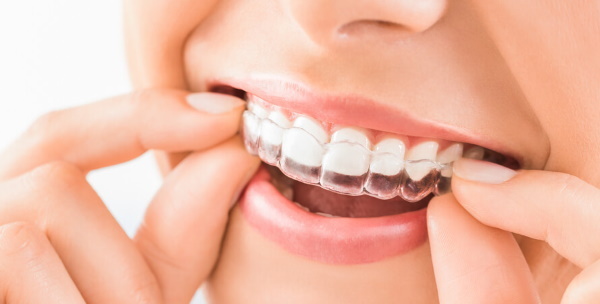
The mouthguard must be changed after 2-3 weeks. Each new mouthguard has a different size, since it corresponds to the movement of the dentition during the correction process. Before putting on the removable structure, you need to wash your hands thoroughly with soap and water. New trays taken out of the packaging must also be rinsed in warm water.
Stages of putting on the mouthguard:
- First you need to make sure which of the caps is designed for the upper and lower jaw. The order in which the garments are donned does not matter.
- In order to put on the mouthguard, you first need to fix it on the front teeth and press down slightly. Aligner snaps into place with a slight click. In this case, you should not clench your teeth so as not to damage the removable structure.
- If you experience severe discomfort or severe pain while wearing aligners, you should stop using them and consult an orthodontist.
How to shoot
In order not to damage the mouthguard and not harm the teeth, it is also necessary to remove the product correctly:
- Remove the aligner with your fingers, starting with the lateral teeth and moving towards the opposite side.
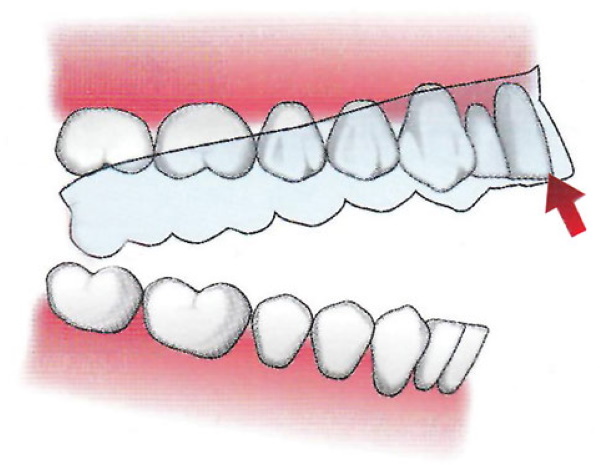
- It is forbidden to use sharp objects to remove the mouthguard.
- It is necessary to remove the product in case of urgent need (during meals or oral hygiene). To achieve the result, wear trays should be at least 20 hours a day.
- After removing the caps, they must be rinsed under water, removed the remaining liquid and stored in a specially designed container.
Oral hygiene rules
Mouthguards should be removed while eating and brushing your teeth. For oral hygiene, a standard set is sufficient - a toothbrush, paste and floss. The teeth must be brushed 2 times a day - in the morning and in the evening.
After each meal, the mouth should be rinsed with warm water and floss should be used to get rid of any food debris in the interdental space. Chewing gum is prohibited when using aligners. There are no other dietary restrictions.
Construction storage rules
Mouth guards should be cleaned 2 times a day with a soft bristled brush and a little toothpaste. It is forbidden to soak the aligners in the mouthwash to avoid mechanical damage to the product. At the time of eating, you must put the trays in a special container.
Selection recommendations
When choosing aligners, you should pay attention to the following criteria:
- material of manufacture;
- the level of equipment used for manufacturing;
- the possibility of 3D modeling;
- choice of a specialist.
Mouth guards for teeth straightening (the price depends on the manufacturer of the products), made of thermoplastic, are suitable for clinical cases with a slight twisting of the teeth. Thermoplastic tends to soften under the influence of high temperature and take the desired position after solidification. Such a product was created according to standard parameters without taking into account individual characteristics.
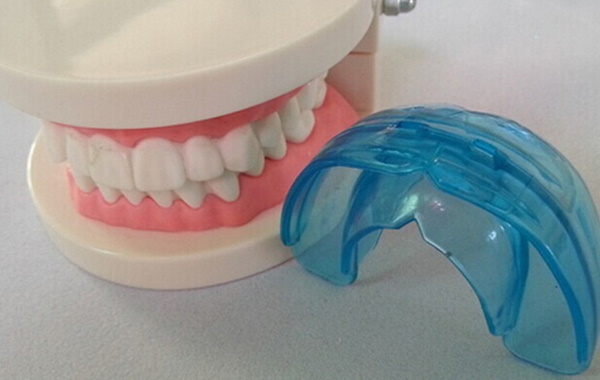
Individual mouth guards are made of durable polyurethane based on plaster and digital impressions, so they are used in more difficult cases:
- gaps between teeth;
- immersion of teeth into bone (intrusion);
- traction of teeth from the bone (extrusion);
- overlapping teeth;
- pushing one of the teeth forward or backward;
- incorrect anatomical arrangement of teeth in a row.
There are clinical cases in which the mouthguards are forbidden to use:
- pronounced displacement of the jaw;
- the occurrence of an allergy to the polymer material from which the mouthguards are made.
- maxillofacial anomalies;
- acute stages of gum disease.
In such cases, braces are considered an alternative option for removable structures. When choosing caps, you should pay attention to the possibility of three-dimensional modeling. The computer program will allow you to simulate the final result and take into account all the nuances of the dentition correction. It is recommended to contact clinics that work with orthodontic modules.
They have several advantages:
- the ability to combine scan data of dental units and CT data;
- the ability to simulate the movement of the coronal part of the dental unit and its root, which will avoid cases of the root part going beyond the redistribution of bone tissue;
- minimal likelihood of errors in modeling.
Thanks to the presence of an additional visualization module, it is possible to visually demonstrate to the patient the scenario of the movement of the dentition in different projections.
Dignity
Alignment caps for teeth straightening (the price for products made abroad is much higher) have a number of advantages over other orthodontic systems:
- mouthguards are more aesthetically pleasing than classic vestibular braces, which ensures the patient's psychological comfort;
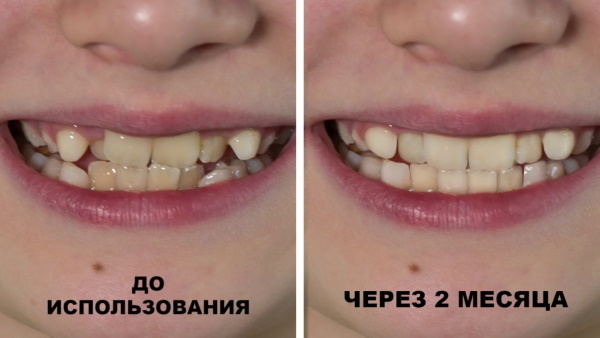
- have a minimum weight;
- do not limit the choice of food;
- securely fixed due to the use of dense silicone or polymers;
- do not affect the level of oral hygiene and do not complicate the process of dental care;
- do not injure the oral mucosa;
- make it possible to organize not a staged, but a simultaneous movement of all dental units;
- comfortable to use;
- provide quick addiction and painlessness (a feeling of slight discomfort is observed within 7-14 days);
- make it possible to use remineralizing or whitening drugs;
- hygienic compared to the bracket system, which reduces the risk of caries and inflammatory processes in the periodontium.
In contrast to bracket systems, with the help of which the correction occurs gradually along the planes, during treatment with mouth guards, simultaneous and equal movement of dental units is achieved.
Flaws
Alignment aligners have a number of disadvantages, the main one of which is associated with the price of the product.
Other disadvantages of a removable design include:
- not suitable for children under 12 years of age;
- have a narrow range of uses;
- have contraindications;
- increase the risk of injury to the gingival margin;
- duration of manufacture;
Some dentists prefer braces because they feel they are more controlled mechanisms. Whereas the effectiveness of wearing aligners depends on the human factor. The use of mouth guards requires constant discipline from the patient and adherence to all recommendations of the orthodontist. This can also be attributed to disadvantages.
Mouth guards are used not only for teeth straightening, but also for malocclusion. Aligners are made of transparent thin material, do not cause discomfort and are absolutely painless. Thanks to the use of 3D technologies, the patient has the opportunity to trace all stages of treatment in advance and assess the future result.
Video about aligners for teeth straightening
Alignment aligners:
